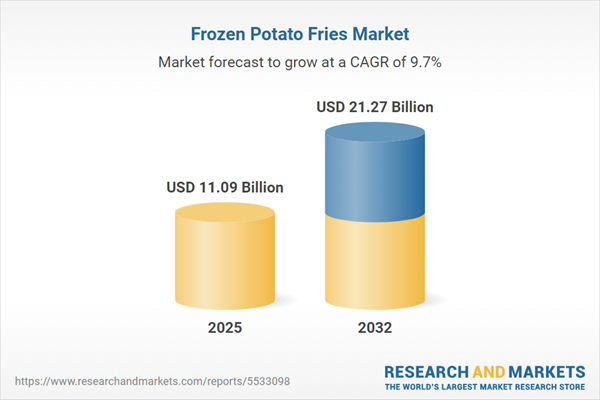Speak directly to the analyst to clarify any post sales queries you may have.
The frozen potato fries market is rapidly evolving, driven by shifting consumer demand, supply chain innovation, and technological progress. Senior leaders seeking a clear understanding of this industry’s future direction will find actionable insights across evolving product formats, channel dynamics, and regulatory impacts.
Market Snapshot: Frozen Potato Fries Market
The Frozen Potato Fries Market grew from USD 10.14 billion in 2024 to USD 11.09 billion in 2025. It is expected to continue growing at a CAGR of 9.69%, reaching USD 21.27 billion by 2032. This robust expansion is supported by increased demand for convenience foods, diversification in fry types, and industry-wide investment in processing and supply chain optimization. The market’s consistent year-over-year growth highlights its enduring relevance for industry participants and investors navigating the global food sector.
Scope & Segmentation
This market research delivers comprehensive coverage of the frozen potato fries landscape, breaking it down by product type, format, packaging, end user, customer profiles, distribution channels, regions, and leading companies. Segmentation enables senior decision-makers to pinpoint high-opportunity segments and tailor strategy accordingly.
- Types: Crinkle-cut fries, curly fries, shoestring fries, steak fries, straight-cut fries, waffle fries.
- Product Form: Pre-cooked, ready-to-cook.
- Packaging Type: Bag, box, tray.
- End User: Cafes, fast food chains, restaurants.
- Customer Type: Bulk buyers, household buyers.
- Distribution Channel: Offline (direct sale, distributor network), online.
- Regions Covered: Americas (North America, Latin America), Europe, Middle East & Africa (Europe, Middle East, Africa), Asia-Pacific (including major economies across each region).
- Company Analysis: Agrarfrost GmbH, Agristo N.V., Cavendish Farms Inc by J.D. Irving Group of Companies, Damaco Group, Himalaya Food International Ltd., J.R. Simplot Company, Kipco-Damaco N.V., Kraft Foods Group, Inc., Lutosa N.V., Nomad Foods Limited.
Key Takeaways for Senior Leaders
- Consumer preferences toward ready-to-cook and pre-cooked products are fueling product innovation, with manufacturers expanding beyond traditional fry types to varied textures and formats.
- Strategic emphasis on packaging—ranging from bulk bags to portion-controlled boxes—supports differentiation and addresses both commercial and household buyers’ requirements.
- Sustainability initiatives, such as responsible sourcing and eco-friendly manufacturing, are influencing buying decisions, supply chain configuration, and long-term brand equity.
- Integration of digital platforms and AI in supply chain management enhances efficiency, improves inventory control, and mitigates disruptions caused by volatile logistics.
- Collaborative ventures among ingredient specialists, packaging providers, and quick-service restaurant operators are enabling new product launches with extended shelf life and improved convenience.
- Market growth is shaped by regional nuances such as regulatory compliance in Europe, flavor innovation in the Americas, and growing demand for convenience foods in Asia-Pacific.
Assessing Tariff Impact: United States Frozen Fries Supply Chains
The recent introduction of US tariffs on imported frozen potato fries has led to significant revisions in global supply chains. Manufacturers are diversifying sourcing, strengthening relationships with regional growers, and investing in domestic processing to mitigate duty-related cost pressures. Pricing strategies have shifted, with efforts to maintain margin integrity seen in direct-to-consumer channels and blended product sourcing. These dynamics contribute to a more agile and resilient supply chain that supports continued market stability in a changing regulatory environment.
Methodology & Data Sources
This report integrates executive-level interviews, comprehensive secondary research, and analytical tools to triangulate key market insights. Inputs include trade publications, regulatory filings, and sustainability data, with segmentation informed by product portfolio audits and channel analysis. Alignment with industry experts ensures each recommendation reflects current sector realities.
Why This Report Matters
- Identify growth opportunities by segmenting the market across product type, channel, and region, giving stakeholders a roadmap for targeted strategic investments.
- Assess emerging risks and regulatory factors, supporting informed decisions in procurement, operations, and regional expansion.
- Benchmark your organization’s innovation, sustainability, and supply chain management practices against leading industry players.
Conclusion
With robust growth, active innovation, and region-specific trends, the frozen potato fries market presents compelling opportunities for companies equipped to adapt. Strategic focus on segmentation, operational flexibility, and technology will position stakeholders for future success in this dynamic sector.
Additional Product Information:
- Purchase of this report includes 1 year online access with quarterly updates.
- This report can be updated on request. Please contact our Customer Experience team using the Ask a Question widget on our website.
Table of Contents
3. Executive Summary
4. Market Overview
7. Cumulative Impact of Artificial Intelligence 2025
Companies Mentioned
The companies profiled in this Frozen Potato Fries market report include:- Agrarfrost GmbH
- Agristo N.V.
- Cavendish Farms Inc by J.D. Irving Group of Companies
- Damaco Group
- Himalaya Food International Ltd.
- J.R. Simplot Company
- Kipco-Damaco N.V.
- Kraft Foods Group, Inc.
- Lutosa N.V.
- Nomad Foods Limited
Table Information
| Report Attribute | Details |
|---|---|
| No. of Pages | 184 |
| Published | November 2025 |
| Forecast Period | 2025 - 2032 |
| Estimated Market Value ( USD | $ 11.09 Billion |
| Forecasted Market Value ( USD | $ 21.27 Billion |
| Compound Annual Growth Rate | 9.6% |
| Regions Covered | Global |
| No. of Companies Mentioned | 11 |









